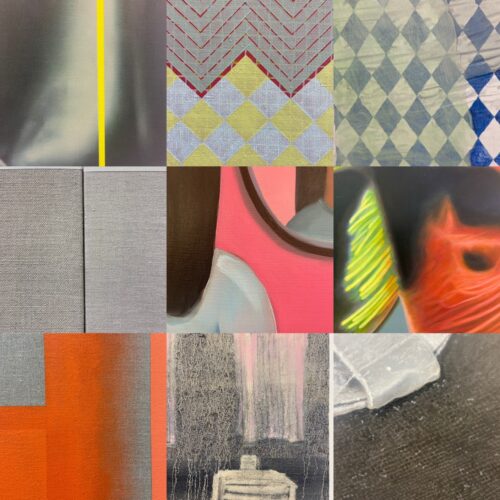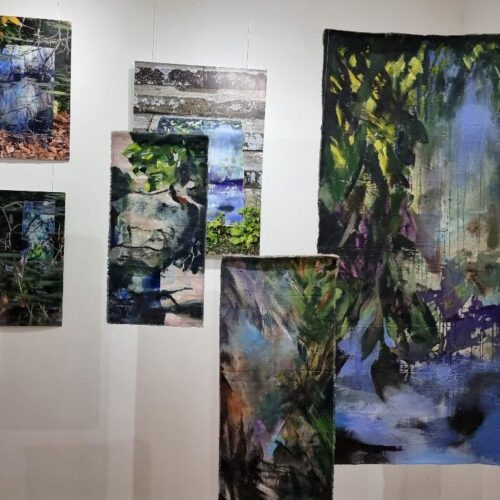
Study Visit to Yorkshire Sculpture Park – Miró and Anish Kapoor
Despite some of the worst June rain seen, we had a good day at Yorkshire Sculpture Park. OCA student Trauti Hard reports:
‘Gathering in the entrance to the main building of YSP, we decided what to do considering the mist and torrential rain outside. Any wandering around in the park and looking at work in the open air was obviously out of the question. The general consensus was to see the Miró exhibition in the Underground Gallery and then, after lunch, to take the shuttle bus up to Longside for the Kapoor.
The indoor part of the Miró exhibition is spread out over four galleries and a project room which shows original models for sculptures, found objects used and an interesting film of Roland Penrose talking to the artist about his work over a period of time. Miró (1893 – 1983) did not start with sculpture until he was in his 50’s. The majority of the work was done in his 70’s and 80’s, with a burst of activity after the death of Franco in 1975.
Gerald gave us an interesting overview of Miró’s surrealist sympathies. Miró was much influenced by childhood images, the continuity and fecundity of nature,and the Catalan culture. Recurrent motifs in his painting and his sculpture are the sun and the moon, symbolising the balance of nature, and birds. He used found, everyday objects in many of his sculptures – a doll’s body and limbs, a flattened basket, oddly shaped fruit, a baby’s chair -and called them ‘phantasmagorical monsters’, easily understood when looking at some of them.

Some of the large black bronze sculptures seem blown-up, scaled up to a size where they are monumental, e.g. ‘Oiseaulunaire’ and ‘Oiseausolaire’; others have a whimsical, playful effect, e.g. the colourful ‘Jeunefilles’évadant’ and ‘La Caresse d’un oiseau’ and some of the small bronzes in the last gallery, like ‘Personnageà la plume’, ‘Coq’ (Picasso did something very similar), ‘Femme au long nez’ and ‘Femme aux beaux seins’ – even some of the titles are humorous.
One tends to associate Miró with his colourful paintings, prints and posters, of which there are also some in every room of the Gallery, but this exhibition introduces us to his work as a sculptor, giving us a quite dazzling display – some of it never shown before – of what he achieved in the latter part of his life.
Luckily the shuttle bus was big enough to take most of us up to Longside for the Anish Kapoor Flashback exhibition. This gallery is just one huge open space with wonderful views over the countryside towards Bretton Hall.
The Flashback exhibitions (previous ones were about Bridget Riley and Gary Hume), organised by the Arts Council, show the development of the artist over a period of time. The earliest works in the Kapoor exhibition are from 1982 (mixed media and pigment) and the latest from 2000 (‘Turning Water into Mirror, Blood into Sky’). The early pigment works reference the shapes and colours of India: colourful pigments covering a variety of forms reminiscent of human body parts, Indian sculptures etc.
Void spaces play an important part in Kapoor’s work as could be seen in‘Adam’, a sandstone block with a recess carved out of it covered in dark blue pigment, and ‘Void’ , a round fibreglass shape, mounted on the wall, with a hole cut out of its centre, and the whole piece covered in blue pigment reminiscent of the Yves Klein blue. Looking at these pieces, it is difficult to see that there is a ‘void’ without testing it by putting an arm in (which one is of course not allowed to do). They draw, nearly suck, you in. There are examples of his mirrored surfaces which are beautiful to look at, reflecting the visitor and the surroundings in them. The most recent work – a revolving steel drum with blood-coloured liquid in it – seemed to draw the least reaction from everybody, other than puzzlement.
AnishKapoor does not like to give explanations of his work. He wants the visitor to decide for what he or she feels and sees and experiences the world.
I think everybody agreed that both exhibitions were well worth seeing.’






Thanks for a very informative and enjoyable visit to the sculpture Park. It was great to meet (and be educated) by tutors and to meet other students. Despite the terrible weather it was a great success.